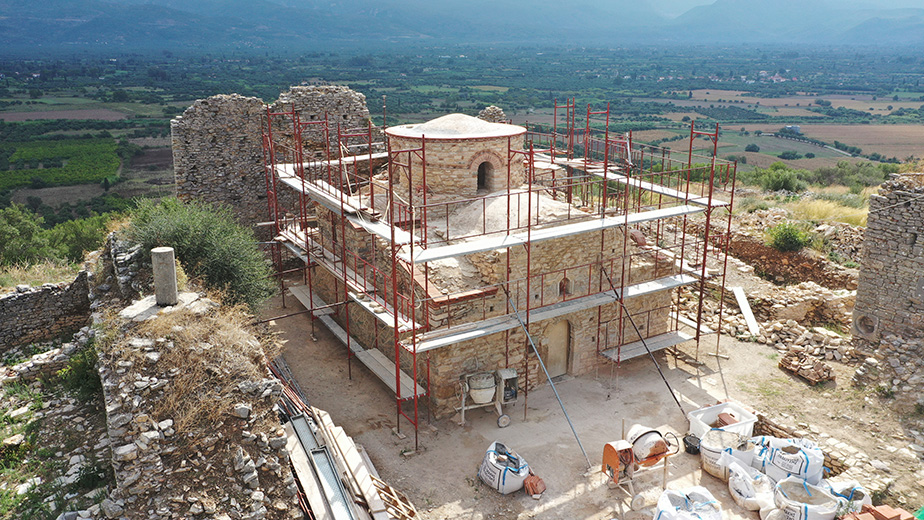

Project Title: Restoration of the Church of Agia Kyriaki at Pidima and Conservation of its Wall Paintings
Region: Peloponnese
Regional Unit: Messenia
Municipality: Kalamata
Municipal Unit: Arfara
Local Community: Pidima
Operational Programme: “Peloponnese 2021–2027”

In 2021, the project “Restoration of the Church of Agia Kyriaki at Pidima and Conservation of its Wall Paintings” was included in the National Strategic Reference Framework (NSRF) 2021–2027.
The project had a total budget of €245,000 and was implemented by the Ephorate of Antiquities of Messenia through the method of direct administration (self-supervision).
The works began in March 2022 and were completed in December 2023.
Main Objective
The restoration and structural reinforcement of the Church of Agia Kyriaki at Pidima, an emblematic monument of the wider region, as well as the conservation of its wall paintings.
Description
The Church of Agia Kyriaki stands on the outskirts of the modern settlement of Pidima, near the ruins of the castle of the same name, still visible on the steep eastern hill nearby.
It is a cross-in-square church of the simplest variation of the type, with exterior dimensions of 5.81 × 3.52 m.
The apse of the sanctuary projects to the east, while the only entrance door opens in the middle of the western side, having been considerably modified in later periods.
Limited ceramic decoration, including dentil bands and narrow friezes of slanted or zigzag bricks, adorns the tympana of the transept. The monument dates to the late 14th century and is one of the most important Byzantine monuments of the wider area.
The interior wall paintings, belonging to a single decorative phase, are preserved in poor condition. They include scenes from the Christological cycle in the vaults, and a single scene from the Life of the Virgin (The Presentation of the Virgin) in the northern tympanum. In the southern tympanum, a damaged donor’s inscription was uncovered. Based on stylistic and iconographic features, the wall paintings can be dated to the late 14th century.
Condition and Damage
The monument faced structural problems and deterioration of its mural decoration. The main structural issues were due to seismic activity and the addition of a later, makeshift annex on the west side, which caused a slight eastward displacement of the church.
Due to insufficient waterproofing and damaged or missing pointing on the exterior masonry, significant moisture problems developed inside, resulting in cracks in the plaster and extensive losses of wall paintings.
Additional damage to the painted surfaces included whitewash layers, salts, soot, deep and superficial cracks, and areas of flaking paint.
Works Carried Out
-
Archaeological excavation around the church to stabilize the foundations and construct a drainage trench.
-
Installation of tie rods to strengthen the structural stability of the monument.
-
Repointing of the façades and application of hydraulic lime grout injections on both sides of the masonry.
-
Demolition of the later external narthex.
-
Removal of modern French roof tiles, cleaning and repair of the vaults.
-
Restoration of the ceramic decoration.
-
Roof drainage adjustments and re-roofing with new handmade large roof tiles.
-
Stabilization and conservation of the painted decoration.
-
Installation of a new wooden door and a Byzantine-style wooden iconostasis.
-
Relocation of electricity poles to reduce the visual disturbance to the monument.
-
Installation of an informational sign and creation of a visitor leaflet.
Benefits
The project resolved the structural, aesthetic, and construction problems of the monument, enhanced its historical, archaeological, and artistic value, and brought to light its significant building phases and wall paintings.
Its ultimate goal is the safe return of the monument to liturgical use, so that it may once again become an active part of community life and a point of attraction for visitors, including persons with disabilities (PWDs).

















